Section #9 - Growing opposition to slavery triggers domestic violence and a schism in America’s churches
Chapter 106: America’s Drive To Explore The West Picks Up Momentum
1769 Forward
Western Exploration Milestones Prior To 1840
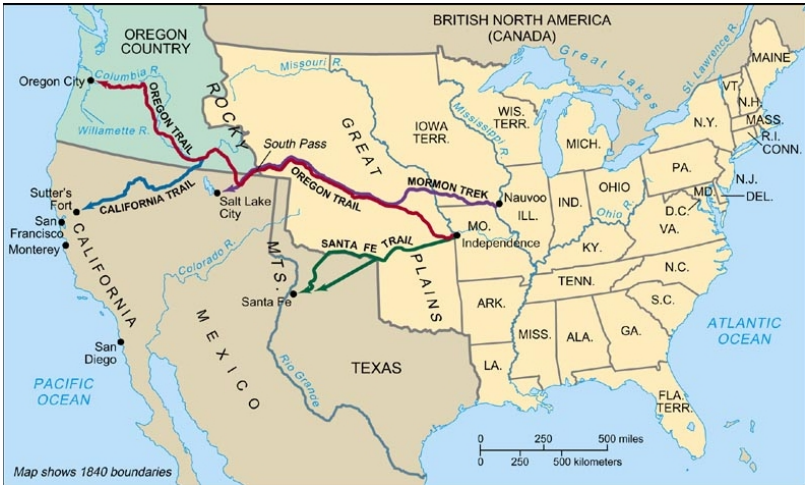
While Webster and Ashburton are resolving border disputes centered on the Atlantic coast, America continues to turn its attention toward the West, the vast frontier land across the Mississippi, still claimed by Spain.
By 1800 overland routes through the Appalachian range have taken early settlers like Daniel Boone through Kentucky into Missouri. The Scottish fur trader, Alexander Mackenzie, has completed two expeditions across Canada, from Montreal to the Pacific Ocean. Captain Robert Gray of Rhode Island has sailed from Boston around the tip of South America at Cape Horn, and on to what he names the Columbia River in Oregon.
By 1820 Thomas Jefferson’s dream of exploring land routes to the west coast has been realized in expeditions led by Meriwether Lewis, William Clark and Zebulon Pike. The allure of great wealth to be had in the fur trade has drawn the likes of John Jacob Astor to establish a commercially viable outpost on the Oregon coast.
Trail blazing follows across east to west pathways founded by America’s native tribes. The Oregon Trail to the Pacific Northwest; the California Trail branch leading south to Sacramento; the Santa Fe Trail through New Mexico, then connecting with the Old Spanish Trail to Los Angeles. Along with these trails come settlers and commerce and the prospect of new states to join the Union. Arkansas becomes the second addition west of the Mississippi in 1836, the same year that a brash band of ranchers lays claim to the Republic of Texas.
With the east now tamed, the message to the venturesome is “go west.” The timing and origin of this advice remains in some dispute, but according to the native Vermonter and later day Iowa Congressman Josiah Grinnell, the phrase belongs to Horace Greeley, who tells him in 1833:
Go West, young man, go West. There is health in the country, and room away from our crowds of idlers and imbeciles.
Americans Exploring the Far West
| Date | |
| 1769 | Daniel Boone’s expedition crosses the Cumberland Pass |
| 1778 | George Rogers Clark travels down the Ohio river to Vincennes, Indiana |
| 1792 | Captain Robert Gray of Rhode Island sails to the Pacific northwest, names a river the Columbia after his ship and goes 12 miles inland on it. |
| 1793 | Scotsman Alexander Mackenzie crosses Canada to the Pacific for the Northwest Co. |
| 1796 | Thomas Jefferson expresses a wish to map the western lands |
| 1799 | Boone opens a settlement on Spanish territory in Missouri |
| 1803 | Jefferson asks Congress to fund a Northwest Passage exploration |
| 1804 | Lewis and Clark set out from Missouri to the Pacific in Oregon |
| 1806 | Lewis and Clark arrive back home with maps and other records |
| 1806 | Zebulon Pike begins to explore the Arkansas River |
| 1807 | Fur trader John Colter discovers geysers at Yellowstone in Wyoming |
| 1808 | John Jacob Astor founds his American Fur Co. |
| 1811 | The Fort Astoria fur trading outpost is established in northwest Oregon |
| 1821 | Missouri trader William Becknell blazes the southwest Santa Fe trail |
| 1822 | Jim Bridger leads first trapping expedition into the Rocky Mountains |
| 1822 | Jedediah Smith reaches Fort Henry on the Yellowstone River |
| 1823 | Stephen Austin opens the first American settlement in Tejas Province |
| 1824 | Jed Smith is first to cross the “south pass” in the Rocky’s Jim Bridger reaches Great Salt Lake in Utah |
| 1825 | The Erie canal links the Hudson River to Lake Erie |
| 1826 | Jed Smith reaches San Diego, California |
| 1828 | Jed Smith travels up the west coast from California to Oregon |
| 1830 | Jed Smith again crosses the South Pass and onto Oregon |
| 1832 | Indian land declared sovereign in Worcester v State of Georgia ruling |
| 1833 | Bonneville expedition to Idaho, Nevada and the California Trail |
| 1834 | Ft Laramie trading post opens on North Platte river in Wyoming |
| 1836 | Arkansas admitted to the Union; Republic of Texas starts up |
| 1837 | Michigan admitted to the Union |
1824
Jedediah Smith Locates The “South Pass” And Circumnavigates The West Coast
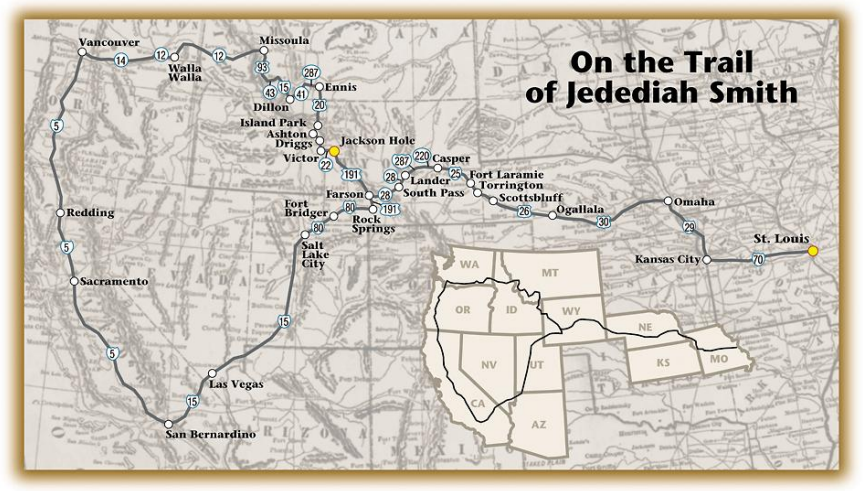
The legendary mountain man, Jedediah Smith, is born in New York in 1799 and explores the west between 1822 and his untimely death in 1831.
Smith’s destiny is fixed as a youth by pouring over a copy of Lewis and Clark’s journals and landing a job on a Lake Erie boat, where he first encounters the fur trade. This lures him west to St. Louis, where, in 1822, he signs on as a member of the Rocky Mountain Fur Company.
The company is owned by General William Ashley and Major Andrew Henry, both veterans of the War of 1812. The men they recruit become famous as “Ashley’s Hundred,” known for their exploratory daring and their success with fur trapping and trading.
Two of Ashley’s men become famous throughout the region – one is Jim Bridger (1804-1881), the other is Jedediah Smith.
Both men travel up the Missouri River in 1822 to the mouth of the Yellowstone River in North Dakota. After a winter of trapping in the area, twelve members of the party are killed by Arikawa tribesmen while traveling back down the river. Both Smith and Bridger survive, and later mount a reprisal attack alongside their Lakota Sioux allies. The sobriquet “Captain Smith” is granted for Jedediah’s bravery in action, something further attested to by a reported life and death struggle he survives with a grizzly bear.
Smith’s greatest contribution as a western explorer occurs in 1824 when, with guidance from local Crows, he becomes the first white man to cross the Rocky Mountains at the “South Pass” – which subsequently serves as the principal pathway to Idaho, Nevada and California.
Smith’s prowess as a trapper leads to business partnerships, first with Ashley and later with William Sublette, who goes on to found Ft. Laramie, the re-supply depot for future travelers along the Oregon Trail.
Between 1824 and 1830, Jedediah Smith executes a vast circumference of the west, from the South Pass down through Utah and Nevada to San Bernadino, California, then up the entire coast to Vancouver, and back west via Montana and Wyoming to the Rockies crossing.
This journey marks him as the first white man to cross Nevada and the Sierra Range, and to transverse the coast.
He departs St. Louis on April 10, 1831 with a party of 74 men, carrying goods to trade in Santa Fe. They proceed some 670 miles west to Wagon Bed Springs, Kansas. At a camp there, Smith breaks off from the group to scout for water, and is never seen again.
Several months later, however, some of his personal belongings show up in Santa Fe in the hands of a local “commanchero,” a Mexican who trades with the Commanches. This leads to speculation that Smith was probably killed by their tribesmen.
1833-1834
The Bonneville Expedition Opens A New Path Into California
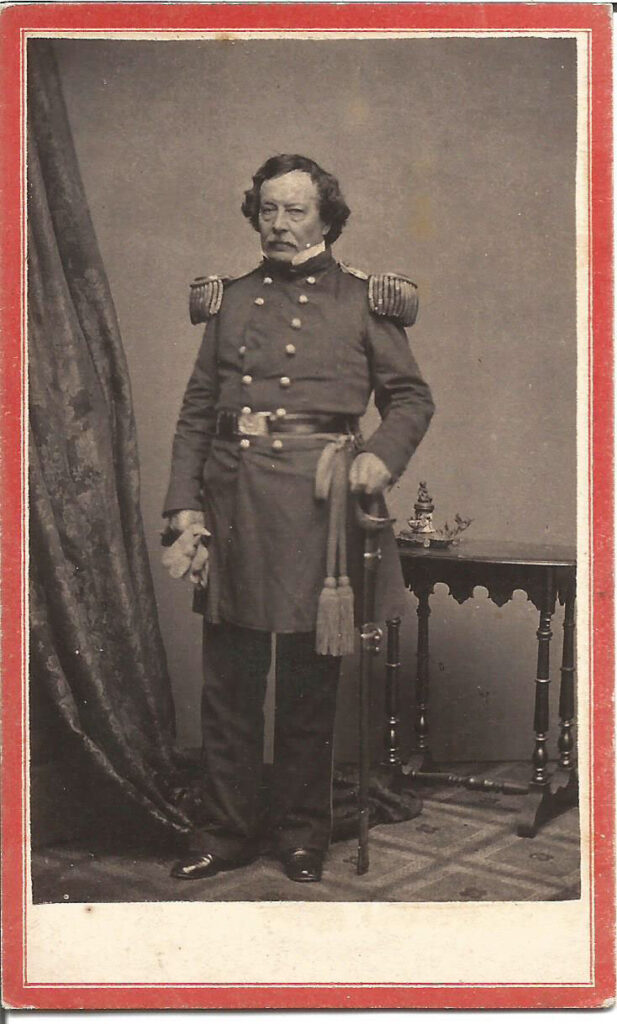
de Bonneville (1796-1876)
Benjamin Louis Eulalie de Bonneville is a Parisian by birth who arrives in America in 1803 at age seven, courtesy of an Atlantic crossing paid for by his godfather, the patriot pamphleteer, Thomas Paine. He graduates from West Point in two years and serves at several frontier outposts – Ft. Smith (Arkansas), Ft, Gibson (Oklahoma) and the Jefferson Barracks (Missouri).
Like Jed Smith, he is bitten by the exploration bug, and asks for a two year leave of absence from the army to join an expedition to the “Oregon Country,” sponsored by the tycoon John Jacob Astor and his American Fur Company. The time is 1832 and the boundaries within.
Oregon are still hotly disputed between Britain and the United States Bonneville’s leave is granted on the condition that he reports back to his commanders on the situation he finds out west.
He assembles a party of 110 men and departs from Missouri in May 1832. He heads across Missouri to the Platte River and follows it through Nebraska and into Wyoming, where he builds a fur trading post along the Green River dubbed Fort Bonneville, and remains there through the winter of 1832-33.
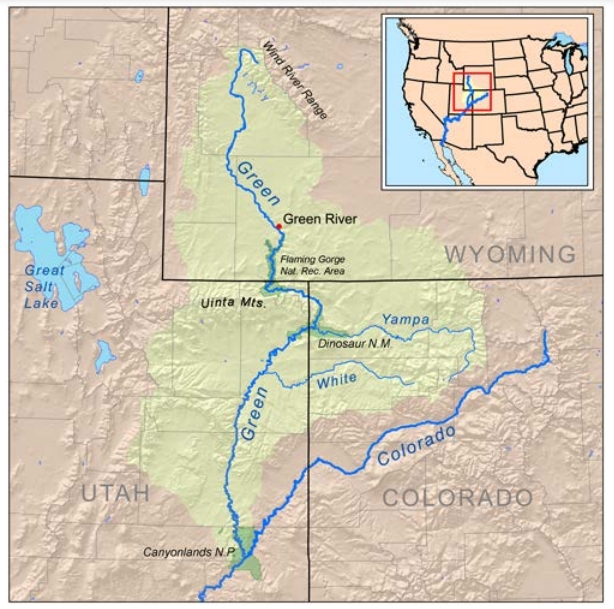
In the Spring of 1833, Bonneville continues west into Idaho, following the Snake River route.
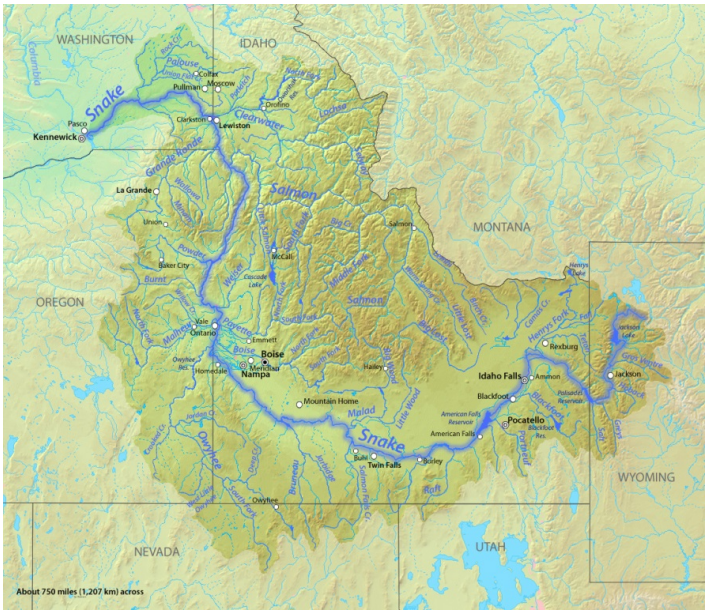
With Utah and the Great Salt Lake sitting due south of his route, he makes what will prove to be a crucial decision – by splitting his party in two. His personal charge is to continue west to the “Oregon Country,” but he either senses, or has been encouraged by the army, to also find a route into California.
Whatever the cause, on July 27, 1833, he breaks off a contingent of fifty – led by his right hand mountain man, Joe Walker – to explore the Great Salt Lake region and search for a path to Alta California.
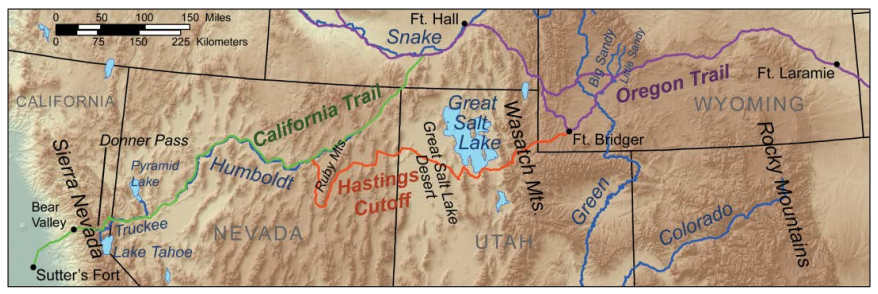
Walker’s journey pays off. He drifts southwest through Utah and finally picks up the Humboldt River which runs horizontally through Nevada to the base of the Sierra Mountains. Once there, his band ascends the Virginia Creek to the Virginia Lakes, followed by a final 1700-foot climb to the summit at Mono Pass, some 10,600 feet above sea level. The journal kept by one Zenas Leonard says they cross the snow-covered pass in mid-October 1833.
The descent down the western slope of the Sierra range is treacherous and they are soon slaughtering their own horses for food. As Leonard records:
Twenty-four of our horses died since we reached the top of the mountain, seventeen which we eat the best parts….We searched for a place that was a smooth and gradual in the descent as possible…and by fastening ropes around (our horses) let them down one at a time without doing them any harm.
Each day is spent searching for a path through the remaining, albeit smaller, mountains. They encounter great sequoia (redwood) trees along the way, and finally follow an Indian path to the Stanislaus River, which takes them into the Great California Valley, some 75 miles south of Sacramento. The Spanish town of Monterrey is their final destination and they remain there until February 14, 1834, when they head back home.
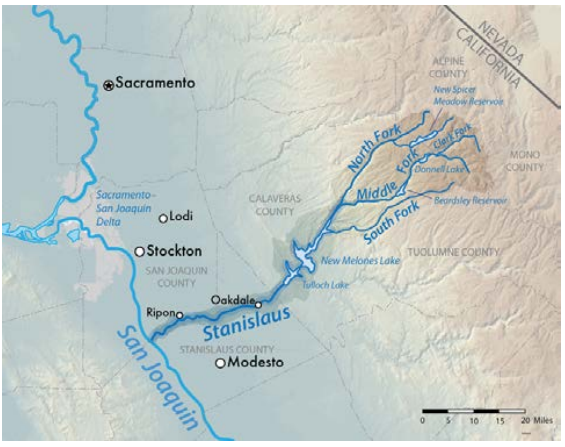
In locating the Humboldt River path and weaving through the Sierras, Walker contributes to what becomes known as the “California Trail” — travelled over by thousands of Americans after gold is discovered fifteen years later, in 1848. Walker himself lives on to 1876, leading John C. Fremont’s third expedition west in 1845, and then mounting a successful search for gold around Prescott, Arizona.
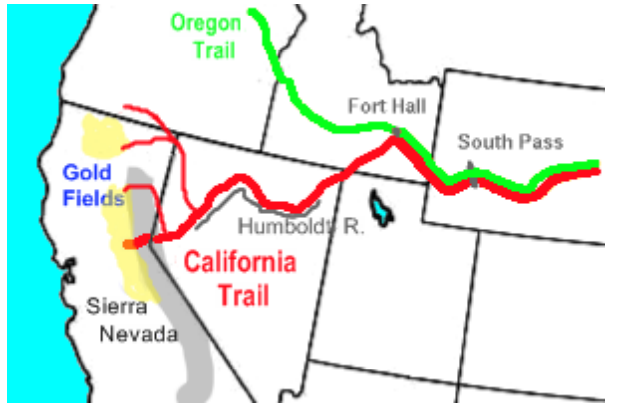
Meanwhile Bonneville’s main party backtracks into Wyoming to conduct fur trading with the Shoshone tribe, and ends up at the fort he constructed on the way out. He stays there until January 1834, when he resumes his trek west across the Snake River and into Oregon, stopping in March 1834 in tribal territory at Ft. Nez Perce, owned by the rival Hudson Bay Company.
He will make two separate attempts to trade with the Hudson firm at the fort, but is turned away both times. The British simply want nothing to do with their long-time rival, JJ Astor. This same rejection repeats itself when he heads further west toward Ft. Vancouver – and, discouraged, he turns back east, staying the rest of the winter in upper Utah, again trading with the Shoshones. In April 1835 Bonneville heads home, arriving at Independence, Missouri in August.
Once there he finds that his army commission has been revoked after overstaying his two year leave by almost fifteen months. He is, however, well connected and makes his appeal to John Jacob Astor and Andrew Jackson’s Secretary of War, Lewis Cass, who reinstates him. After service at various western forts, he fights in the Mexican War at Veracruz, is promoted to Colonel, and given command over the Department of New Mexico. At the start of the Civil War, he is breveted as Brigadier General and helps recruit troops in Missouri. He dies in the state in 1871, age eighty-two.